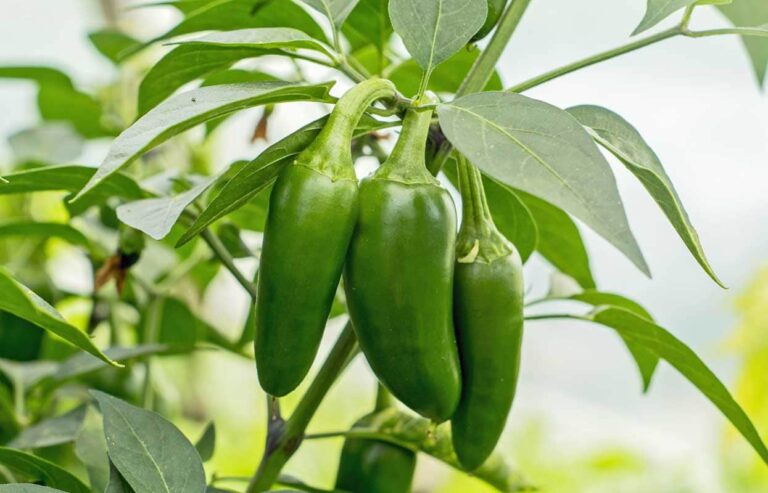Jalapeños (Capiscum annuum ‘Jalapeño’) – native to Central America and South America – is part of the Capsicum annuum species, which includes other popular peppers like sweet bell, habanero, and cayenne.
They’re typically harvested while still green, but if left on the plant, they’ll ripen to a red, orange, or yellow color. It is important to note that jalapeño plants contain capsaicin in their leaves and fruits, which can cause a burning sensation and may be harmful to both humans and pets.
Common Jalapeno varieties:
- Goliath Jalapeños
- Jalafuego Jalapeños
- Jedi Jalapeños
- El Jefe Jalapeños
- Purple Jalapeños
Care
These plants require full sun exposure for at least six hours each day to thrive. It’s also crucial to plant them in fertile, well-drained soil with a slightly acidic to neutral pH level. Be sure to water them regularly, keeping the soil moist but not waterlogged.
- Soil: To help your jalapeño peppers grow their best, it’s important to provide them with soil that is fertile, well-draining, and moist. Keep in mind that the pH level of the soil should be slightly acidic to neutral, as these plants don’t do well in soil that is too dense or too soggy.
- Water: Make sure to water your plants when the soil feels dry about an inch down, but be careful not to overdo it and cause the soil to become waterlogged. To help keep the soil moist and healthy, you can add a thick layer of mulch around the plants.
- Light: When you’re planting jalapeño peppers, it’s important to make sure they get plenty of sunlight. These plants do best in full sun, which means at least six hours of direct sunlight on most days.
- Temperature: Jalapeño peppers are happiest when they’re growing in temperatures that are just right. They like it when it’s between 65 and 85 degrees Fahrenheit during the day and between 60 to 70 degrees Fahrenheit at night. So, try to keep your jalapeño plants in a spot where the temperature stays in that comfortable range.
Propagation
To propagate jalapeño peppers, you can plant seeds in the garden when soil temperatures reach at least 65 degrees Fahrenheit or start them indoors around eight to 10 weeks before your area’s last projected frost date. Choose a sunny location with organically rich and well-drained soil and keep them away from other nightshade family members to avoid disease transmission. Space plants about 14 to 16 inches apart and use stakes for taller varieties to support the weight of the fruits.
Common Pests
Frequently Asked Questions
These plants do best in full sun, which means at least six hours of direct sunlight on most days.
How long can a jalapeno plant live?
Under ideal conditions, jalapeno plants have a lifespan of 10 years.
What happens if you leave jalapenos on the plant?
Leaving jalapeno peppers on the plant for too long can slow down the production of new flowers and fruits, ultimately reducing the overall yield. It is best to harvest the peppers when they have reached their mature size and are glossy green.
How many jalapenos can you get off one plant?
Throughout the growing season, a single pepper plant can yield multiple harvests, producing around 25 to 35 pods per plant.
